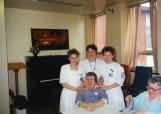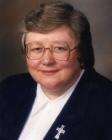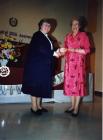1
In 1966 A.V. Roe Canada, manager of the iron ore mines ceased operations; this happened just one year after the Dr. Templeman Health Center opened.Overnight, the population and prosperity of the island plummeted and many families were forced to move off the island. The hospital, which was equipped to care for a growing community, was now facing an uncertain future. Though services were available, it was only a matter of time before the population was too small to sustain a fully functioning health care facility.
2
In 1961 the population on Bell Island was 12281. In just 10 years the number of residents decreased by half, to just 6079 by 1971. Due to the shortage of work on the island, many families were forced to leave in search for employment. It was inevitable that the health care system on the island would have to adapt to the changing population.3
In the early 1980s the role of the health centre started to transform. As the residency levels dropped, the population demographics changed. There were fewer young adults living on the island and 10% of the population was over the age of 65. Although there was still a significantly high number of children on the island, the out migration of young adults meant that there would be fewer new families starting on Bell Island. This trend added to the shift in population demographics.4
With the new age demographics, hospital officials recognized that there was an increasing need for senior care on the island, but also that there was no longer a large enough population to justify keeping many of the specialized services that the hospital offered. As a result, sections of the hospital such as the operating theatre were closed, the 40 bed hospital became a 20 bed facility, and many other services were reduced.5
Up until this point the hospital on Bell Island functioned as a stand alone unit, with its own board and budget. With the decline in population, however, it was difficult for the hospital to sustain itself and the decision was made for St. Clare's Mercy Hospital, one of the major hospitals in St. John's, to assume governance of the Dr. Walter Templeman Health Centre.7
Once becoming a part of St. Clare's Sister Elizabeth Davis, the C.E.O. of St. Clare's, and the health officials on Bell Island agreed that they needed to start focusing on the island's current population, concentrating on services that would protect and improve the community's health.9
Nursing staff and hospital resident posing for a photograph1990
Dr. Walter Templeman Health Centre, Wabana, Bell Island, Newfoundland, Canada

10
Long term care for seniors became the new focus of the hospital and the facility was redesigned so that there were 12 long term care beds, six acute care beds, one palliative care bed, and one convalescence bed. Since there were no senior complexes on the island at that time, it was imperative that the hospital be able to accommodate those individuals who did not have family on the island or were no longer able to care for themselves at home.11
Hospitals under the Health Care Corporation of St. John's14 March 2006
Dr. Walter Templeman Health Centre, Wabana, Bell Island, Newfoundland, Canada

12
Today, the hospital on Bell Island is currently going through another transition. As the health care system in Canada moves towards a primary health care system, small community hospitals such as the Bell Island Hospital are getting a new chance at life.13
Children's field trip to hospital1990
Dr. Walter Templeman Health Centre, Wabana, Bell Island, Newfoundland, Canada


